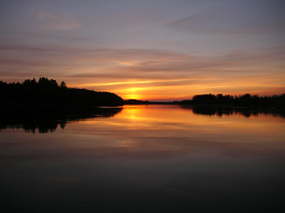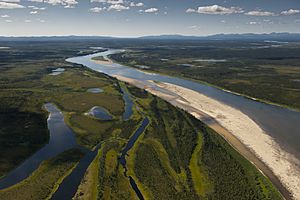Kobuk River facts for kids
Quick facts for kids Kobuk |
|
| River | |
|
Sunset over the Kobuk River
|
|
| Countries | United States |
|---|---|
| States | Alaska |
| Tributaries | |
| - left | Squirrel River, Tutsuksuk River |
| - right | Salmon River, Adillik River |
| Source | Walker Lake |
| Secondary source | Endicott Mountains |
| Mouth | Kobuk Delta |
| - elevation | 0 m (0 ft) |
| Length | 280 km (174 mi) |
| Basin | 12,300 km² (4,749 sq mi) |
| Discharge | for Bering Strait |
| - average | 283 m³/s (9,994 cu ft/s) |
| - max | 3,000 m³/s (105,944 cu ft/s) |
| - min | 40 m³/s (1,413 cu ft/s) |
The Kobuk River is a long river in northwestern Alaska, United States. It is found in the Arctic region. People sometimes call it by other names like Kooak or Kowak.
The river is about 280 miles (451 km) long. It flows through a large area of land called a basin, which is about 12,300 square miles (32,000 km2) big. This makes the Kobuk River one of the biggest rivers in northwest Alaska.
In some places, the river can be as wide as 1,500 feet (460 m). In its lower and middle parts, the water flows at a speed of 3–5 miles per hour (5–8 km per hour).
The land around the Kobuk River, called the Kobuk River Basin, has different types of landscapes. The average height of the land is about 1,300 feet (400 m) above sea level. Some areas are close to sea level, while others are very high, up to 11,400 feet (3,475 m). You can find low, rolling mountains, flat plains, and even rugged, rocky areas.
Animals of the Kobuk River
The Kobuk River is home to many animals. It has a lot of a special fish called sheefish. Sheefish are large fish that eat other fish. They are a type of whitefish and are related to salmon. These fish live all over the Arctic. In the autumn, they swim to the upper parts of the river to lay their eggs.
A huge group of caribou, called the Western Arctic Caribou Herd, uses the Kobuk River valley. They come here to spend the winter months.
History of the Kobuk River
The word "Kobuk" comes from the Inuit language and means "big river." Native people have lived, hunted, and fished along the Kobuk River for at least 12,500 years. For a very long time, the river has been an important way for people living inland to travel.
In 1898, there was a short period when many people came to the river looking for gold. This event was called the Kobuk River Stampede. About 2,000 people, called prospectors, joined in. They heard rumors of gold along the Kobuk and its smaller rivers. Miners traveled from Seattle and San Francisco by ship to reach the mouth of the Kobuk.
When they arrived, local native people told them that the rumors were not true. Only about 800 prospectors continued to travel up the river. In the end, very little or no gold was found, and only in a few small rivers that flow into the Kobuk.
In 1980, the United States Congress decided to protect a part of the river. They named 110 miles (177 km) of the river, starting from Walker Lake and going downstream, as the Kobuk Wild and Scenic River. This is part of the National Wild and Scenic Rivers System. The river is a great place for people who enjoy floating down rivers in boats.
Images for kids
-
Permafrost regions along the Kobuk River





